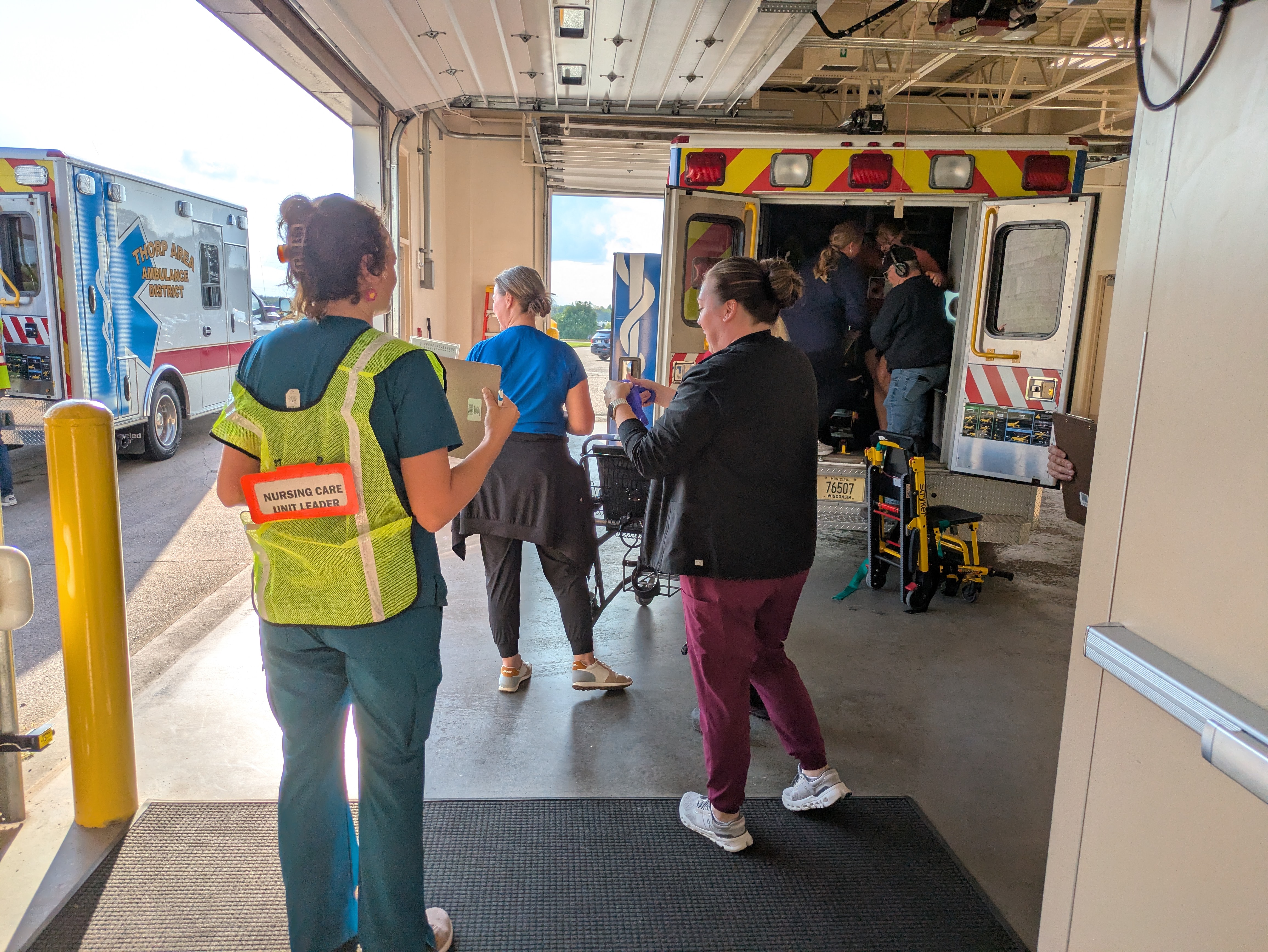Aspirus Stanley Hospital Hosts Annual Mass Casualty Drill

(Stanley, Wis)- In an ongoing effort to strengthen community preparedness, Aspirus Stanley Hospital opened its doors on Wednesday, September 10 for its annual Mass Casualty Drill.
Hospital and clinic staff, first responders, and community partners joined together for a simulated emergency designed to test, evaluate and strengthen their ability to respond to large-scale crises. This year’s drill simulated a bus rollover accident involving 12 to 15 volunteer patients.
Emergency Medical Services (EMS) from Stanley, Thorp, Boyd, Owen, and Cadott responded first to the mock crash, where they triaged and stabilized patients before transporting them to Aspirus Stanley’s Emergency Department. Once at the hospital, staff were tasked with rapidly assessing, treating, and coordinating care in a high-pressure environment that mirrors a real disaster.
“Mass casualty situations often don’t give you time to think , so you have to be ready,” explained Spencer Hager, RN, one of the hospital’s Emergency Department nurses and the lead organizer of the drill. “These trainings allow our staff and our community partners to walk through the chaos in a safe, controlled setting so that if the real thing ever happens, we’re better prepared to serve our neighbors.”
A Community-Wide Effort
The drill is much more than a hospital exercise; it’s a true community event. In addition to local EMS services, the Stanley-Boyd Area School District provided the use of a school bus and parking lot to stage the simulated accident. Volunteers from the community took on the role of injured passengers, adding realism to the scenario while giving staff a chance to practice triage and treatment on multiple patients at once.
“Our community is at the heart of everything we do,” said Nicole Dekan, RN, Emergency Department Supervisor at Aspirus Stanley Hospital. “It’s incredible to see so many partners EMS teams, the school district, even volunteer patients come together with one goal: to make sure we are ready to respond if disaster ever strikes.”
Raising the Bar in Training
For the first time the drill also included air medical transport participation which is a major step forward in realism as it is a critical piece of emergency response in rural areas. One of those was from Aspirus Medevac which focused on the practice of “hot loads.” A hot load refers to loading or unloading patients while the helicopter’s rotors are still turning and the engine is running. It’s a widespread practice in air medical transport when speed is critical for patient survival.
“Helicopter involvement adds a whole new layer of training,” Hager noted. “It forces us to think about transport logistics, communication, and safety around aircraft all things that would come into play during a real mass casualty event.”
Preparing for the Unexpected
Inside the hospital, the drill simulated the activation of the hospital’s Mass Casualty Incident Command System, with staff filling roles ranging from triage and direct patient care to communications and family support. Teams were stationed in the emergency department, clinic, surgery areas, and conference rooms, simulating how patients and families would be managed across multiple departments.
“Aspirus Stanley is a small hospital with a big responsibility,” said Anne Sadowska, VP-Chief Administrative Officer, WI Northwest Division, Aspirus Health. “Our patients and our communities count on us to be ready, no matter the situation. These drills push our teams to the limit, but they also highlight the dedication, skill, and heart that our staff bring to every challenge.”
At the end of the evening, participants gathered for a debriefing to reflect on lessons learned and identify opportunities for improvement. For Aspirus Stanley, each drill is less about perfection and more about progress.
“Every year we learn something new, and every year we get stronger as a team,” Dekan said. “That’s the whole point, we want to be ready for the unexpected, and we want our community to know we’re prepared to take care of them.”
Putting Community First
While the drill will only last three hours, its impact will extend far beyond the evening of September 10. For staff, it’s an opportunity to sharpen skills and strengthen relationships across departments. For first responders, it’s a chance to practice side-by-side with hospital teams. And for the community, it’s a powerful reminder that preparation saves lives.
“This is about more than a drill,” Hager said. “It’s about making sure that if something terrible ever happens here, the people of Stanley and the surrounding communities can count on us to be ready.”